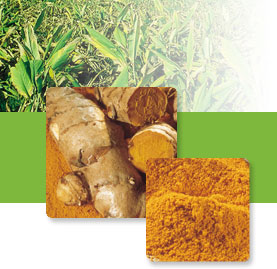 This spice has long been known for its amazing healing properties (just check Wikipedia for a quick review of some of the literature). Well, Turmeric has done it again: in a comprehensive trial that explored the histologic and genetic effects of curcuminoids in animal models, Janet Funk, M.D. (Univ. of Arizona) highlights some very interesting effects of Turmeric on tissue affected by rheumatoid arthritis (RA). Her findings focus on the role of NF-κB (nuclear transcription factor kappa-B), a pro-inflammatory molecule that the body uses to activate genes that cause the short- and long-term changes associated with RA. Turmeric seems to interfere with its expression and theraby reduce the subsequent cascade of inflammation that contributes to chronic pain and joint degradation:
This spice has long been known for its amazing healing properties (just check Wikipedia for a quick review of some of the literature). Well, Turmeric has done it again: in a comprehensive trial that explored the histologic and genetic effects of curcuminoids in animal models, Janet Funk, M.D. (Univ. of Arizona) highlights some very interesting effects of Turmeric on tissue affected by rheumatoid arthritis (RA). Her findings focus on the role of NF-κB (nuclear transcription factor kappa-B), a pro-inflammatory molecule that the body uses to activate genes that cause the short- and long-term changes associated with RA. Turmeric seems to interfere with its expression and theraby reduce the subsequent cascade of inflammation that contributes to chronic pain and joint degradation:"In vivo treatment prevented local activation of NF-κB and the subsequent expression of NF-κB-regulated genes mediating joint inflammation and destruction, including chemokines, cyclooxygenase 2, and RANKL [the receptor activator of NF-κB ligand]," the investigators wrote.
We herbalists know that Turmeric's anti-inflammatory effects are not limited to RA. We've been using this plant since it became available to the West - and Ayurvedic healers have been using it for over 4000 years. But now, thanks to modern science, we have this pearl of wisdom from Doctor Funk:
"Just as the willow bark provided relief for arthritis patients before the advent of aspirin, it would appear that the underground stem (rhizome) of a tropical plant may also hold promise for the treatment of joint inflammation and destruction."
Brilliant.




